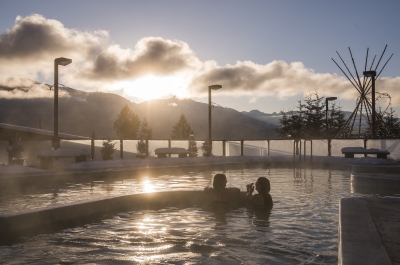My Caving Adventure at Cody Caves
My Caving Adventure at Cody Caves
Last weekend, I had the opportunity to explore Cody Caves for the first time. I’ve been in caves before, but after this experience, I would say this was my first time truly ‘caving’!
The trip began with a 20-minute drive up the mountain to the parking lot where we geared up in cover-alls, waterproof boots, helmets and lights.
Our guide, Lee, described the geology in the area, how the cave was formed and assured us that locked gate put in place to deter trespassers would also prevent any bears (or other large creatures) from taking up residence inside the cave. To my surprise, we also learned that there are no bats in this cave. Other than the occasional packrat and a healthy population of daddy-long-leg spiders in the cave entrance, I was relieved to find out that there have been no other signs of life within the cave.
From the parking lot, we hiked up a forested trail to reach the cave entrance, which sits at about 2,400 feet on the mountainside. Almost immediately after entering the cave, I felt as though I had entered a whole other world. The air was cool and damp, but felt refreshing and not the least bit stuffy or stagnant. From the entranceway, we quickly moved on to explore the interior chambers of the caves, where the magic really begins.
We scrambled, crawled, and climbed our way through a labyrinth of passageways, narrow tunnels, steep drops and so-called ‘squeezes’ to be rewarded with open chambers filled with pristine soda straws, stalagmites, stalactites, calcite and beautifully layered sedimentary rock formations. When studying these naturally formed galleries of art, I was amazed at the incredible power it took for the water to dissolve the limestone and create these unique, incredibly fragile formations.
The ‘squeezes’, very true to the their name, where gaps between the rocks smaller than you’d think a human could fit. After watching Lee gracefully arrange his body to fit the space, I realized that it was indeed possible, and less difficult than it appears. It became evident that caving is less about physical strength and more about challenging yourself mentally. It requires the ability to suppress any childhood fears of the dark or small spaces.
There is also a certain level of excitement and thrill about putting your trust into the hands of your guide and following them deeper and deeper into the earth. Luckily for us, Lee was incredibly knowledgeable and talked us through each new challenge with confidence and a level of calmness acquired from 25+ years of experience. He reminded us on more than one occasion that caving involves “jamming yourself into the crevices in the rock using your elbows, knees and hips while making sure you’ve always got more than one reliable foothold or handhold”. This was important advice for preventing slips and falls and reducing the workload on your muscles to conserve energy.
After exploring the deepest corners of the cave, we returned downstream back towards the cave entrance. Just when I thought the adventure was coming to an end, Lee surprised us by bringing us to a set of ladders parallel to an underground waterfall – Cody Falls. The water was icy cold, and crystal clear, offering us a refreshing opportunity to clean the dirt and muck off our hands and face.
We arrived back at the parking lot tired, wet, still a bit dirty, but filled with inspiration and a sense of accomplishment. We pushed the edges of our comfort zones and experienced the thrill of being able to explore a hidden underground world. This is an adventure I wouldn’t hesitate to recommend to anyone from families to avid cavers and anything in between!
Some interesting facts I learned:
- The cave began to form when limestone beds laid down almost 600 million years ago were thrust up by mountain building forces occurring 170 million years ago.
- In the Cody Caves System, an underground stream flows for over a kilometer through ancient limestone.
- It was once thought that the inner chambers of the cave were walled with gold ore. This is unfortunately untrue; the caves are however lined with an impressive display of calcite formations.
- The calcite formations, being extremely old and fragile can be damaged in seconds and regenerate at a rate of only one cubic centimeter per century!
- The explorabel length of the cave is in excess of 1.5km
- Contrary to what the survey implies, the cave has not been fully explored. The cave is likely larger than originally thought with undiscovered passageways and chambers.
- Cody Caves is one of the best-known cave systems in BC and Cody Caves Provincial Park was the first subterranean park created in the province.
- The Ainsworth Hot Springs originate in the Cody Caves area and are considered to be one of the best commercial hot springs in BC
- The boxwork formations are considered to be among the best in the world, protruding up to 20.3 cm, whereas 2.5 to 5 cm is average. Boxwork is an uncommon type of mineral structure, or speleogen (similar to a speleothem, but formed by erosion rather than accretion)
I hope your adventure at Cody Caves is as wonderful as mine was!
by Brad Higham
The Region
TRAVEL BOOK
Read our visitors guide online or order a copy of the official visitor's guide and map for our region.














